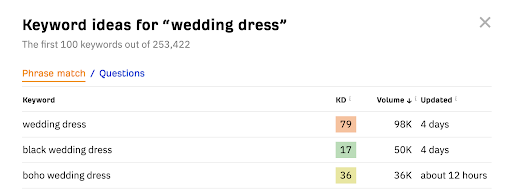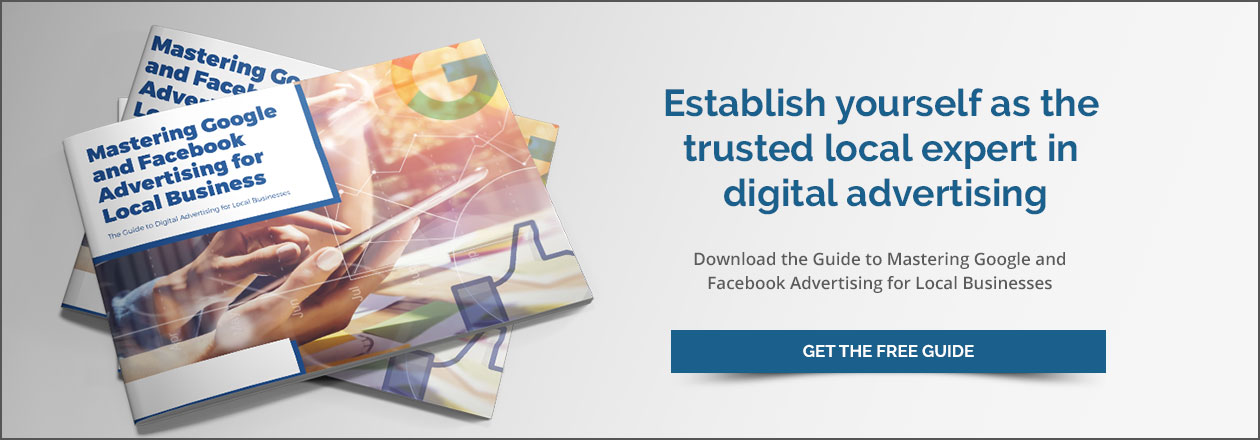Digital advertising largely operates on a pay-per-click (PPC) basis, meaning that advertisers only pay when someone clicks on their ad. But how do you determine how much you’re going to pay, and how can you ensure the most clicks from potential buyers at the most favorable rate? The answer is PPC bid management, a must-have skill for anyone selling digital advertising services.
Establish yourself as the trusted local expert in digital advertising. Download "White label: Mastering Google and Facebook advertising for local businesses" right now.
It’s not a simple question of minimizing your cost-per-click (CPC) altogether: if you bid too low, your client’s ads likely won’t be seen. Instead, pay per click bid management is all about striking an ideal balance at which profits can be maximized. That’s exactly what you’ll learn to do in this article.
Table of Contents
- What exactly is PPC bid management?
- Mastering PPC bid management: Strategies and best practices
- Frequently asked questions
What exactly is PPC bid management?
Put simply, PPC bid management is the process of planning, managing, and adjusting the amount you’re willing to pay for each click on a given ad. It’s an essential tool if you want to control your advertising costs and generate a healthy return on investment (ROI) for your PPC campaigns.
To understand the rationale behind these strategies and best practices for successful pay per click bid management, it helps to have a solid grounding in how PPC advertising works.
Whether you’re new to digital advertising or you’re here for a refresher, here’s a quick recap:
PPC advertising is a real-time virtual auction, where instead of bidding for art or other valuables, you bid on keywords or phrases. These phrases are what users type into the search bar when looking for something. For example, a busy parent in Seattle might search for “house cleaners in Seattle.”
Advertisers decide which keywords are most relevant to their business, and how much they’re willing to pay each time a user clicks their ad after using one of these keywords. This is their bid. Every time a user types a keyword into Google’s search bar, an auction for that keyword is initiated, and the highest bidder usually gets their ad displayed.
Mastering PPC bid management: Strategies and best practices
There’s one important way in which bidding for PPC differs from other auctions: the highest bid isn’t the only factor that determines which ad gets displayed. Relevance and quality matter, too, so your ads management strategy should take these factors into consideration.
Keyword bid management
Keyword bid management is all about selecting the bid that will produce the highest return on ad spend (ROAS) for the advertiser. The aim is to optimize bids based on the value and performance of individual keywords. Bidding too high can lead to costly conversions that dilute profits, while bidding too low can mean your ads never see the light of day.
Let’s take a closer look at keyword-level bidding strategies that can help you strike the right balance.
Choosing between manual and automated keyword bid management
One of the first decisions you’ll make when setting up a PPC campaign is whether to use manual or automated bidding.
Manual bidding gives you full control over your bids, giving you the flexibility to adjust bids and control your budget as needed. But it can be time-consuming—especially at scale—and it’s generally a good idea to have some experience under your belt before trying it.
Automated bidding uses algorithms to adjust bids for you based on a set of predefined goals that you provide, like a target cost per acquisition (CPA). This option doesn’t require the same intensive hands-on approach as manual bidding, but it’s still a good idea to keep an eye on campaigns and make manual adjustments here and there.
If you’re a reseller of PPC management tools and your SMB clients handle their advertising themselves, automated bidding is usually the safest bet. If you handle campaigns in-house or through white-label PPC experts working on your behalf, you’ll likely still lean toward automated bidding in most cases—especially as your agency grows—and occasionally use manual bidding strategies when they’re likely to produce great results based on past experience.
Creating parameters with bid modifiers
More granular keyword bid management is possible, even when using automatic bidding, by using bid modifiers. These adjustment levers allow you to increase or decrease your bids based on specific criteria like the user’s device, location, or time of day.
For example, if your data reveals that mobile users are more likely to convert, you can increase your bids for mobile users. This way, you can maximize ROAS across device types despite different conversion rates. Similarly, you might want to decrease bids for low-performing locations or time slots, leaving more ad budget to be used for high-converting locations and times.
Try different bidding strategies
Bidding strategies define the goal that the bidding algorithm will aim for, and choosing different bidding strategies can have a major impact on the result of your campaign. Your choice of bidding strategy can greatly impact your campaign’s results. For example, in Google Ads, the Smart Bidding feature allows you to select strategies like:
- Maximize conversions
- Target CPA
- Target ROAS
- Maximize conversion value
Maximizing conversions or hitting a target CPA is ideal for maximizing sales or generating more leads, while using target ROAS or maximum conversion value as bidding strategies may be more effective for maximizing profits. The right choice comes down to your client’s goals and the specifics of the campaign.
Keyword performance metric-based bid adjustments
Every keyword performs differently, and while you can get an estimate by looking at keyword data, you won’t know for sure until you start targeting it and evaluate the metrics.
To do this, regularly check the click-through rate (CTR), conversion rate, CPA and other key metrics for each individual keyword being used in your campaign. Then, adjust accordingly: for example, you might want to increase your bid for keywords with a low CPA, since this will likely bring down your overall new customer acquisition cost.
Ad group and campaign PPC bid management strategies
Pay per click bid management at the ad group and campaign level affects all of the ads nestled in these categories. These broader PPC bid management strategies help manage your client’s budget at a higher level, ensuring the overall ad strategy aligns with their marketing and business goals.
Segmenting ad groups for more control over bids
Ad groups are clusters of ads that are grouped together around a theme and a cluster of keywords. Through ad group segmentation, you can cluster ads together around a product type, keyword strategy, stage in the buying cycle, or any other grouping that makes sense for your digital marketing strategy.
If you’re familiar with audience segmentation in email marketing, the principle here is the same. Through segmenting, you can boost the personalization of your ad delivery, increasing the chances of any given ad resonating with those who see it. A great way to decrease your CPC is to deliver high-quality, relevant ads—more on this in a moment—and segmentation allows you to do just that.
Not only can you tailor the ads and keywords used in each ad group, but you can also control your bid strategy for each grouping based on its relative performance. Just as you can make metric-based bid adjustments to keywords, you can make bid adjustments to your ad groups.
Optimize your budget across campaigns
In the Google Ads platform, each campaign can only have one type of ad, such as search ads or display ads. If you want to use a variety of ad types for your client’s advertising strategies, multiple campaigns are required. This means you’ll need to make decisions about how best to allocate your budget across them.
With the goal of maximizing ROI, make sure to regularly assess the performance metrics of all client campaigns and adjust as needed to help your client’s reach their goals.
Make bid adjustments based on campaign performance goals
Just as you adjust keyword-level bids based on their performance metrics, you should keep an eye on campaign-level metrics and make bid adjustments to ensure your goals are met.
For example, if the goal of a campaign is to increase brand awareness, you might focus on metrics like impressions and clicks, making adjustments to maximize these. Conversely, if a campaign goal is to increase sales, adjusting bids to maximize conversion rates while maintaining a sustainable CPA would be an effective strategy.
Take advantage of peak hours with ad scheduling
Your ads and campaigns don’t have to run uniformly around the clock. Try increasing your bid during peak hours to take advantage of the moments when shoppers are most likely to convert.
These peak times might vary depending on which platform you’re using to run PPC ads, based on when users of the platform are most active.
Get even more granular by implementing dayparting
To get even more granular optimization through ad scheduling, try dayparting. This term refers to the adjustment of bids for different times of the day—or the week—based on customer behavior patterns.
Each client account you manage will have different times that produce an optimal ROAS. Dayparting is a powerful pay per click bid management trick that allows you to control exactly when ads can be seen based on this data.
To make use of this strategy, it’s best to let a campaign run for at least a few days—ideally a week—to collect enough data to identify peak times. Then, just increase your bids during these hours.
The result? Improved visibility and conversion potential, without having to increase your budget.
Competitive pay per click bid management strategies
PPC bid management is, by definition, a competitive arena. You’re competing with other advertisers for the same coveted keywords used by prospective customers. Understanding the competitive landscape in which your clients operate is essential to succeeding and carving out a profitable piece of the pie.
Let’s take a look at some competitive bidding strategies that will help you get an edge over your rivals.
Use keyword research to identify profitable, low-competition keywords
Keyword research tools can be used to identify the volume and competition associated with any keyword. Volume refers to the number of monthly searches incorporating the word or term, while competition (also sometimes called keyword difficulty) refers to the number of other advertisers bidding on it.
The ideal scenario is a high volume, low-competition keyword. These can be hard to come by, but long-tail keywords can sometimes bring up hidden gems. For example, take a look at these results from Ahrefs’ free keyword generator tool:
“Wedding dress” is a high-volume keyword, and the difficulty is 70 out of 100, meaning it’s very difficult to rank for this popular phrase. However, “black wedding dress” still has a fairly high search volume, but it has a much more favorable keyword difficulty score. Finally, “boho wedding dress” falls somewhere in the middle, with a slightly lower search volume and higher keyword difficulty.
If your client is a wedding dress retailer with black wedding dresses in their catalog, this could be a great, high-ROAS keyword to target.
The bottom line: keyword research is essential for identifying the best keyword targeting opportunities in a competitive landscape.
Spy on competitor bids to inform bid adjustments
Let’s face it, the best digital marketing strategies always require a bit of sleuthing. Keeping an eye on your competitors’ bidding activity can provide useful insights for your own PPC bid management strategies.
For example, if you notice competitors consistently outbidding you on certain keywords, it might be worth reevaluating your bids for these keywords. However, always consider the profitability and strategic importance of a keyword before getting into a bidding war over it.
The goal isn’t just to outbid your competitors, but to do so in a way that aligns with your client’s business objectives and budget constraint, maximizing ROAS.
Use bid simulators for no-risk competitive analysis
Manual and Smart Bidding simulators are available right in the Google Ads platform. As their name implies, these provide a no-risk way to estimate how changes to your PPC bid management strategies might impact outcomes given existing competition
While these aren’t a crystal ball, playing with them to try out different parameters, like max CPC, can provide a wealth of insight without having to blow advertising dollars on real-world testing.
Use ad assets to increase visibility and CTR
Ad assets (formerly called ad extensions) are a fantastic—and free—way to enhance your ads’ visibility and attractiveness, increasing CTR.
These are add-ons that can be appended to any Google ad to provide additional information about a business, like its location, phone number, or additional links to your site. You can’t control when these appear—Google’s algorithm does that for you based on its predictions of when they’ll boost conversions—but you can make sure they’re all completed in your client’s account.
As far as low-cost marketing techniques go, you can’t beat Ad Assets: they enhance your ads and make them more appealing to users, boosting CTR in the process.
Play around with bidding strategies to find the best approach
There’s no one-size-fits-all approach to competitive PPC bid management, and the best way to discover what does work is through experimentation.
Each account you manage is subject to different factors, like the target audience, campaign objectives, and budget. Continuously testing different PPC bid management strategies will help you arrive at a tailor-made approach for every client.
Sound like a lot of work to handle in-house? Consider using white-label PPC pros who work on your agency’s behalf, leaving you to focus on scaling your business.
Optimizing for quality and relevance
PPC ad platforms, including Google, prioritize high-quality and relevant ads. In other words, it’s not just about the bid strategy: the ad itself has to be appealing and of interest to its audience.
Improve ad relevance, CTR, and the landing page experience
Google’s Quality Score consists of three key components: ad relevance, expected CTR, and the landing page experience. Each of these should be carefully considered and optimized to obtain the best Quality Score possible.
The first of these components, ad relevance, is fairly straightforward: do the keywords associated with an ad line up with its message? Returning to our wedding dress keyword example, if an ad uses the “black wedding dress” keyword, the advertised product should indeed be a black wedding dress. In other words, you shouldn’t try to game the system by using high volume, low competition keywords that aren’t relevant just to get more eyes on your ad.
CTR can be optimized by A/B testing your ads to continuously improve this key metric.
Finally, the landing page is where users will potentially convert. Your landing pages should align with the expectations generated by the ad. They should also be easily navigable, well-designed, and optimized for conversions.
Keep the Quality Score in mind when selecting keywords and optimizing ad copy
Keyword selection plays a double role in helping you create winning ad campaigns. We’ve already discussed the first of these, which is that keywords determine when an ad may be seen by an interested buyer. Additionally, they impact the Quality Score when they’re relevant and accurately aligned to the content of an ad. The result? Your ad will be seen by more motivated buyers, producing a better ROAS over time.
Ad copy should also be closely aligned with selected keywords and with the content of the ad. Stellar ad copy can play a major role in boosting CTR, which also—you guessed it—boosts the Quality Score.
Keep a close eye on landing page load times
Landing page load times severely impact conversion rates. It would be a shame to nail your PPC bid management strategy only to lose customers because the landing page takes 5 seconds to load.
Pro-tip: Bundling PPC and SEO services is a match made in digital marketing heaven, and by optimizing landing page load times, you’ll boost organic local search performance in the process.
Use ad assets to boost performance
Remember those ad assets we talked about earlier? Those can impact your Quality Score too, by making your ads more visible, relevant, and engaging, boosting the Quality Score.
All you have to do is complete the info for these assets in your client’s Google account, and let the algorithm do the rest.
Common PPC bid management mistakes to avoid
Save yourself the wasted ad dollars by avoiding these all-too-common mistakes:
- Over- and under-bidding on keywords: Overbidding can quickly deplete your budget, while underbidding can result in ads not being shown at all. Balance is the name of the game: your bids should reflect both the value and competition of a keyword.
- Failing to use performance metrics to adjust bids: Continuous tracking and data-informed adjustments are both non-negotiable for maintaining campaign effectiveness and ROI over time.
- Ignoring seasonality and industry trends: Markets evolve, and your bidding strategy needs to evolve with them to ensure you remain competitive. This means keyword research and competitive research should be ongoing projects.
- Neglecting regular review and optimization: Setting time aside to review your campaigns and bid strategies will ensure you don’t accidentally sink money into ineffective ads.
Frequently asked questions
How does effective bid management impact the performance of PPC campaigns?
Effective PPC bid management plays a vital role in the performance of campaigns. It ensures ads are competitive and visible to the right audience at the right time. By optimizing bids, you can improve your ad ranking, increase CTR, boost conversions, and generate a favorable ROI.
What are the cost implications and potential savings associated with effective PPC bid management?
Effective PPC bid management can prevent overspending on high-cost, low-return keywords, freeing up funds for profitable ones. Improving your Quality Score is another way to decrease your CPC, leading to more clicks and conversions for your budget.


 By
By 
